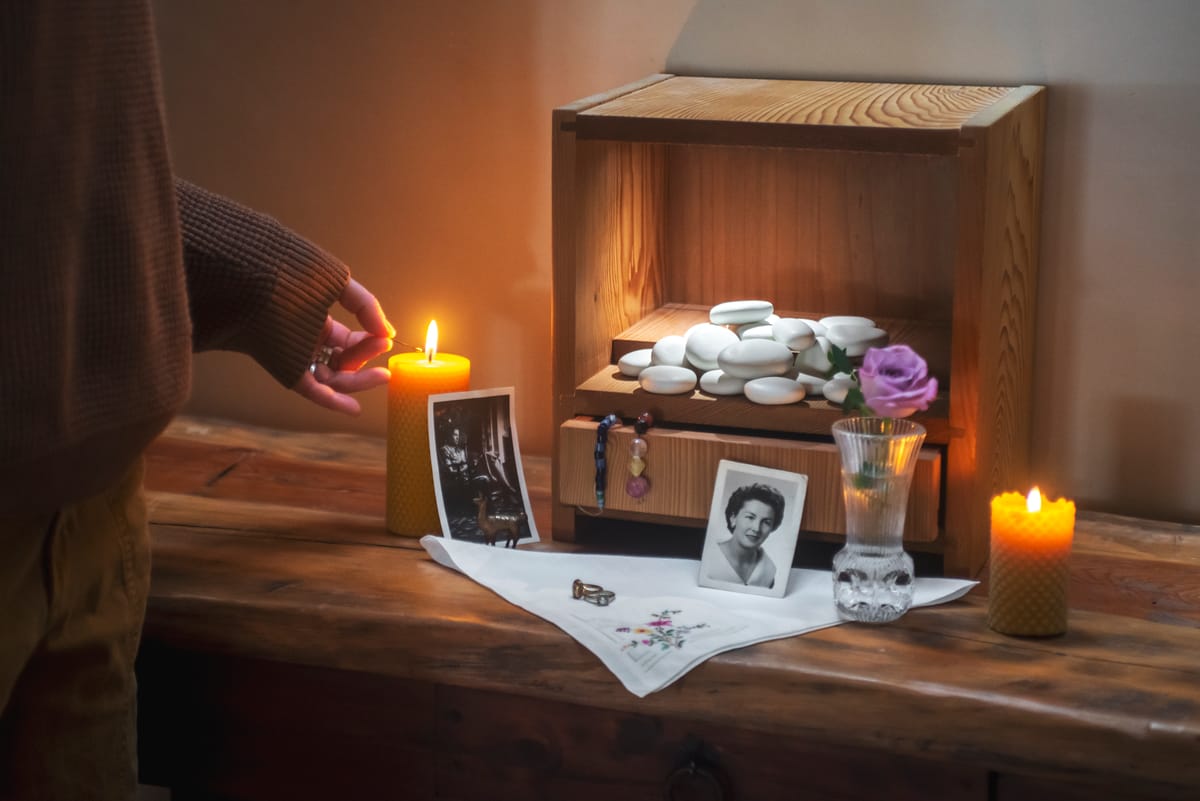Getting Through Today: A Grief Survival Guide for the Hardest Days
Practical crisis strategies for when grief is overwhelming. Learn how to survive the hardest days with gentle, immediate techniques that actually help.

You're reading this because you're hurting. Not the kind of pain that comes with a clear beginning and end, but the suffocating, all-consuming kind that makes it hard to breathe. You may have woken up this morning and wondered how you'll make it until tonight. Or perhaps you're in the middle of the night, chest tight with anxiety, searching for any strategy that might help you survive until dawn.
This is what acute grief looks like. It's not poetic or redemptive. It's raw and disorienting, and it can make even the simplest tasks feel impossible. Right now, you don't need advice about "healing" or "finding meaning." You need to know how to get through the next 60 minutes. That's what this guide offers: specific, immediate strategies to help you survive today. Not tomorrow, not next week. Just today.
The waves of pain you're experiencing are not signs that something is wrong with you. Research on bereavement consistently shows that grief affects every aspect of human functioning, including physical health, cognitive processing, and emotional regulation (O'Connor, 2019). Your body is responding to one of life's most significant stressors, and feeling overwhelmed is a completely natural reaction to an unnatural experience.
Key Takeaways
- Surviving the next hour is enough when grief feels overwhelming; there's no expectation to heal or plan beyond the immediate moment.
- Physical grounding techniques can interrupt panic responses and bring you back to your body when emotional pain feels unbearable.
- Permission to cancel plans, cry, sleep, or do nothing at all is valid self-care during acute grief.
- Major decisions about memorials, belongings, and life changes can wait until you're in a clearer emotional space.
- Crisis resources and professional support are signs of strength, not weakness, when grief becomes unmanageable.
Reflections on love, loss, and the ways we carry them
There are moments in grief that take your breath away. Not just metaphorically, but physically. Your chest tightens, your pulse races, your hands tremble. Many people fear that something is terribly wrong when, in fact, their body is simply responding to deep emotional pain. This isn’t a weakness. It’s biology.
When grief hits with intensity, the brain's threat system activates, the same one that responds to physical danger. Knowing this can be profoundly freeing. You're not "losing control"; your body is trying to protect you. The work, then, is to remind your body that you are safe, gently.
I remember Marissa, a widow in her early 60s, who came to me weeks after her husband's sudden passing. "Every time I think of him, I can't breathe," she said. Together, we practiced grounding. Pressing her feet into the floor, naming what she could see, hear, and touch. At first, she thought it was silly. However, over time, she found herself using these techniques in the middle of the night, when panic would strike. "It doesn't erase the pain," she said, "but it helps me stay here, in this moment."
Grief lives in the body. Grounding is one of the simplest ways to reconnect with it. Start small: notice your breath, press your palms together, name five things in your surroundings.
You can't think your way out of grief, but you can breathe your way through it: one moment, one sensation, one heartbeat at a time.
Cathy Sanchez Babao
Parting Stone Grief Coach
Right Now: The Next 60 Minutes
When grief hits with intensity, your brain's threat response system activates as if you're in physical danger. This isn't weakness; it's neurobiology. Understanding this can help you implement grounding strategies that interrupt the panic cycle and bring you back to the present moment.
Immediate Physical Grounding (2-5 Minutes)
Your first priority is reconnecting with your body. When emotional pain feels unbearable, these techniques can create a crucial pause:
- The 5-4-3-2-1 Sensory Technique: Name 5 things you can see, 4 things you can touch, 3 things you can hear, 2 things you can smell, and 1 thing you can taste. This simple practice engages your prefrontal cortex, the part of your brain responsible for rational thought, and can reduce the intensity of emotional overwhelm (Najavits, 2002).
- Physical Pressure: Press your feet firmly into the floor. Push your hands together as hard as you can for 10 seconds. Hold a pillow against your chest. Physical pressure signals safety to your nervous system and can interrupt the spiral of panic (van der Kolk, 2014).
- Cold Water Reset: Splash cold water on your face or hold an ice cube in your hand. The shock of cold temperature activates the diving reflex, which naturally slows your heart rate and can break through intense emotional states (Kox et al., 2014).
- Breathing Pattern Reset: Breathe in for 4 counts, hold for 4, breathe out for 6. The extended exhale activates your parasympathetic nervous system, which counteracts the panic response. You don't need to do this perfectly; even attempting this pattern can help (Jerath et al., 2015).
@chloebluffcakes Thank you @partingstone 🤍 youve given me an unimaginable gift. One day I will share these with my little sister and carry her wherever we go in life together. #grief #partingstone #loss
♬ Repeat Until Death - Novo Amor
Environmental Safety Adjustments (10-15 Minutes)
Once you've implemented immediate grounding, assess your physical environment. Acute grief can make ordinary spaces feel threatening or overwhelming.
- Create a Comfort Corner: Identify one small space in your home where you feel safest. This might be a chair with a soft blanket, a corner of your bed, or even your bathroom floor. Designate this as your refuge space for the next 24 hours. Give yourself full permission to retreat here without guilt or explanation.
- Reduce Sensory Overload: Turn off news notifications. Dim bright lights. Lower the volume on devices. When your nervous system is already overwhelmed by grief, additional sensory input can push you past your capacity to cope (Stroebe & Schut, 1999).
- Have Water and Simple Food Nearby: Grief disrupts basic self-care. Place a water bottle, crackers, or simple snacks within reach of your comfort space. You don't need to eat a meal; staying minimally hydrated and nourished helps your body manage the physical stress of grieving.
Micro-Actions for the Next Hour (15-20 Minute Increments)
When you can't imagine completing anything substantial, break time into manageable micro-segments:
- Set a 15-Minute Timer: Tell yourself you only need to survive for 15 minutes. When the timer goes off, decide if you can handle another 15 minutes. This technique, used in crisis intervention, makes overwhelming time periods feel manageable (James & Gilliland, 2017).
- Permission Statements: Say these out loud, even if you don't believe them yet: "I don't have to be productive today." "It's okay that I'm not okay." "Crying is not weak; it's honest." "I can cancel plans without explanation." These statements counter the internal pressure many grieving people feel to "function normally."
- Single Task Focus: Choose one tiny action: wash your face, change your shirt, walk to the window, send a one-sentence text to someone safe. Completing even one small action can interrupt the feeling of being completely paralyzed by grief.
Tammy from Dayton, Ohio 🖤, who lost her husband, shares how tangible comfort helped during overwhelming moments: "It's been a tangible reminder of my husband that I can both see and hold/touch. I was able to share the stones with my husband's sister, our son and daughter, as well as our young grandchildren."

@ohthatjenny If you would like more information on Parting Stone and the process please dont hesitate to ask. I feel so confident that Chris would love this way of keeping his memory alive. He is SO missed and loved still and always. #partingstone #partingstones #lifeafterloss #griefandloss @PartingStone
♬ original sound - Jenny
Getting Through Today: Hour by Hour
Acute grief changes the experience of time. Hours can feel like days; entire days can disappear in a fog. Here's how to navigate each part of your day when everything feels impossible.
Morning: The Moment You Remember (6 AM to 12 PM)
Waking up is often the cruelest part of grief. For a few seconds, you might forget what happened. Then reality crashes back, and you have to face another day without the person you loved.
- The First 30 Minutes Matter Most: Don't reach for your phone immediately. Give yourself permission to lie still, to cry, to simply exist without demands. If you can, establish a tiny morning ritual: three deep breaths, touching something with comforting texture, looking out a window. Small anchors can help when everything feels unmoored.
- Redefine "Getting Ready": Today, "getting ready" might mean staying in pajamas. It might mean changing into different pajamas. Or it might mean managing to brush your teeth. There is no minimum standard for functioning during acute grief. Any self-care you accomplish is enough.
- Nutrition as Medicine: If eating feels impossible, try liquids. Smoothies, soup, or even ice cream provide calories and hydration. Grief burns enormous amounts of physical energy; your body needs fuel even when your appetite has vanished. Small amounts frequently are better than forcing yourself to eat a full meal (Shear, 2015).
- Give Yourself the Day Off: If you were physically ill with the flu, you wouldn't question staying home from work or other obligations. Acute grief is just as legitimate a reason to step back from normal responsibilities. If you have the option to cancel commitments today, take it without guilt.
Afternoon: When Everyone Expects You to Function (12 PM to 6 PM)
Afternoons can be particularly difficult. The world continues around you, often expecting you to participate in normal routines while you're barely holding yourself together.
- Energy Management, Not Time Management: Forget your usual to-do list. Today's only goals: stay alive, stay safe, be gentle with yourself. Everything else is optional. If you have children or dependents who need care, ask for help. This is not the time for independent strength; it's the time for strategic support.
- The 20-Minute Escape: When grief waves hit during the day, give yourself permission to stop. Set a timer for 20 minutes. Cry, scream into a pillow, rock yourself, lie on the floor. Whatever your body needs to do to release the pressure. Twenty minutes of honest emotional expression is more healing than hours of forced composure.
- Social Buffer Strategies: Well-meaning people may call or text with questions you can't answer. Create a standard response and copy-paste it: "I'm not able to talk right now, but I appreciate you thinking of me." If texting feels like too much, silence your phone. You're not being rude; you're protecting your capacity to survive.
- Physical Movement as Release: If you can, move your body for just five minutes. Walk around your home, stretch, do gentle yoga, or simply shake your arms and legs. Grief gets trapped in the body, and even minimal movement can release some of the physical tension (van der Kolk, 2014).
Evening and Night: When the Darkness Amplifies Everything (6 PM to 6 AM)
Nighttime often intensifies grief. The distractions of daytime fall away, and you're left alone with your thoughts and pain. Many grieving people report that nights are the most unbearable part of the early grief period (Bonanno & Kaltman, 1999).
- Prepare Before Dark: Before evening arrives, set up your environment for comfort. Prepare your comfort space, have water nearby, charge your phone in case you need to reach out to someone, and identify one comforting activity (watching familiar TV, listening to specific music, reading).
- Sleep Disruption is Normal: Grief affects sleep profoundly. You might sleep too much, too little, or wake repeatedly. All of these patterns are common responses to traumatic stress (Germain et al., 2005). If sleep feels impossible, rest is still valuable. Lying down with your eyes closed, even without sleep, gives your body needed recovery time.
- The 3 AM Survival Kit: If you regularly wake in the middle of the night with crushing anxiety, prepare a specific kit: a comforting object to hold, headphones with calming sounds, a journal for writing down intrusive thoughts, and the number of a crisis line if you feel unsafe. Having these resources ready can reduce the panic of waking into grief.
- Permission to Stay Awake: If sleep won't come, stop fighting it. Get up, make tea, sit in a comfortable spot, and do something gentle. Fighting sleeplessness often creates more distress than accepting it. When your body is ready to sleep, it will.
Joanna from Spokane Valley, Washington 🖤, who lost her son unexpectedly, describes finding comfort during the hardest moments: "I find a great comfort in holding the stones. They're smooth and have weight that says 'I am here with you right now.' I can see them where I leave them in the country, in the garden, and in a hidden secret nook. It is a tangible representation that he mattered."

When Waves Hit: Emergency Techniques
Grief doesn't arrive in a steady, manageable stream. It comes in waves, sometimes gentle, sometimes tsunami-force. When a wave hits unexpectedly and you feel like you're drowning, these emergency techniques can help.
Recognizing a Grief Wave
Physical symptoms often arrive first: tightness in your chest, difficulty breathing, dizziness, nausea, or a sensation of unreality. Emotional symptoms include sudden, intense sadness, panic, rage, or numbness. Cognitive symptoms might be racing thoughts, confusion, or an inability to focus. All of these are normal grief responses to loss (Shear et al., 2011).
The STOP Technique for Acute Episodes
- S - Stop: Literally stop what you're doing. If you're safe, close your eyes for a moment.
- T - Take a Breath: One deep breath. You don't need to control your breathing perfectly; just take one intentional breath.
- O - Observe: Notice what you're feeling without judgment. "I'm having a grief wave." "My chest feels tight." "I'm scared." Naming the experience creates distance from it.
- P - Proceed Mindfully: Choose one grounding action from your survival toolkit. This might be calling someone safe, using a physical grounding technique, or moving to your comfort space.
When Panic Accompanies Grief
Panic attacks are common during acute grief. Your nervous system perceives the emotional pain as a threat and responds with a fight-or-flight response. When panic hits:
- Acknowledge Without Fighting: Say out loud, "This is a panic attack. It will pass. I am not dying, even though it feels that way." Panic attacks typically peak within 10 minutes and then subside (Barlow, 2002).
- Focus on Extension: Rather than trying to slow your breathing (which often increases panic), focus on extending your exhale. Breathe in naturally, then breathe out slowly through pursed lips as if blowing out a candle. Repeat until the panic begins to ease.
- Safe Contact: If possible, call or text someone who understands your grief. Hearing another person's voice or receiving reassuring words can help ground you when panic distorts reality.
Crisis Resources When Grief Becomes Unmanageable
There's a critical difference between the normal intensity of acute grief and a genuine crisis where you might harm yourself. If you're experiencing:
- Persistent thoughts about suicide or wishing you were dead
- Specific plans about how you would end your life
- Inability to care for yourself or dependents for multiple days
- Thoughts of harming others
- Complete detachment from reality
These symptoms require immediate professional intervention. Call 988 (Suicide and Crisis Lifeline) or go to your nearest emergency room. Acute grief can trigger mental health crises, particularly when combined with depression or previous trauma. Seeking help is not a failure; it's a recognition that your pain has exceeded your current coping capacity (Shear, 2015).
Research on bereavement intervention shows that early professional support can prevent complicated grief and reduce the risk of long-term mental health consequences (Wittouck et al., 2011). Many communities also offer grief-specific crisis services through hospices, funeral homes, or mental health centers.
Catherine from Ottawa, Ontario 🖤, who lost her father, describes this immediate need for tangible support: "Being able to continue to hold my dad close has been a calming force. One of his stones travels with me wherever I go. I always know that if I need him, he continues to be accessible to me, as he was when he was physically here."
The cremated remains of Garth's mother felt meaningless sitting in his clothing closet for 2 decades. Learn how solidified remains helped dissolve the relationship barrier he felt with her and integrate her memory into daily life.
Decisions That Can Wait
One of the cruelest aspects of early grief is the pressure to make decisions when you're least capable of doing so. People will ask about memorial services, belongings, and future plans. Most of these decisions can wait far longer than anyone suggests.
What Absolutely Does Not Need to Be Decided Today
- Memorial and Burial Choices: If cremation has occurred or the body is being cared for by a funeral home, there is no urgent timeline for final disposition decisions. These choices can wait weeks or even months until you're in a clearer emotional space. Many families make memorial decisions they later regret because they rushed while in shock.
- Belongings and Personal Items: Packing up a loved one's belongings should never happen in the first weeks or months of grief unless there are urgent logistical reasons (like losing housing). Many grief counselors recommend waiting at least six months to a year before making significant decisions about possessions. What feels unbearable to keep now might become precious later.
- Life Changes and Major Decisions: Financial decisions, moving, changing jobs, starting or ending relationships should all be postponed when possible. Acute grief dramatically affects judgment and decision-making capacity. The standard guidance in grief counseling is to avoid major life changes for at least one year after loss (Worden, 2018).
- Memorial Products and Services: When you're ready to think about how to honor your loved one's memory, options exist that don't require immediate action. Services like Parting Stone, which transforms cremated remains into solidified remains over an 8-10 week process, allow families to make thoughtful decisions on their own timeline. These choices aren't about fixing grief or finding immediate comfort; they're about creating meaningful ways to maintain connection when you're ready to consider the future.
Protecting Yourself From Decision Pressure
Many people in early grief report feeling pressured by family members, funeral directors, or their own sense of urgency to "finalize everything." This pressure can be resisted:
- Create a Decision Buffer Person: Designate one trusted friend or family member to field questions about decisions. Give them permission to respond on your behalf: "They're not ready to decide that yet. We'll let you know when they are."
- Practice the Phrase: "I'm not able to make that decision right now. I'll let you know when I'm ready." You don't owe anyone an explanation or timeline. Repeat this phrase as needed, even if it feels uncomfortable.
- Write Down Questions for Later: When people ask about decisions, write them down in a notebook or phone. This acknowledges the question without committing to an answer. Later, when you have more capacity, you can review what actually needs addressing.
Building Your Survival Toolkit
Grief is deeply individual. What helps one person survive a hard day might not work for another. Building your personal survival toolkit involves identifying your specific comfort needs and access points.
Physical Comfort Items
- Texture and Touch: Some people find comfort in soft textures (blankets, stuffed animals, pets), while others need weight and pressure (weighted blankets, tight hugs, heavy quilts). Experiment with what soothes your nervous system. Keep these items accessible in your comfort space.
- Temperature Regulation: Grief can make you feel physically cold or overly hot. Have both cooling items (cold packs, fans) and warming items (heating pads, warm drinks) available. Temperature regulation can help when emotional pain manifests as physical discomfort.
- Comfort Food and Drink: Identify 2-3 foods or drinks that feel comforting and keep them stocked. This isn't about nutrition; it's about having something that brings a tiny moment of comfort when everything else feels terrible.
Emotional Release Options
- Private Expression Spaces: Identify where you can cry, scream, or express rage without worrying about others' reactions. This might be your car, your shower, or a specific room. Knowing you have a designated space for emotional release can reduce the feeling of having to hold everything together constantly.
- Music as Regulation: Create two playlists: one that matches your grief (sad, angry, or reflective music) and one that helps shift your nervous system (calming, grounding, or familiar music). Music can validate emotional states or help transition between them (Saarikallio & Erkkilä, 2007).
- Movement for Release: Physical activity isn't about fitness; it's about releasing the tension that grief creates in your body. Identify movement options that feel doable: gentle stretching, walking around one room, dancing to one song, or simply shaking your hands and arms.
Connection Resources
- Your Safety List: Write down 3-5 people who feel safe and supportive. Include their phone numbers. These should be people who don't pressure you to "feel better" or offer unsolicited advice. When you need connection, you can reach out without having to search for contact information.
- Online Grief Communities: Many people find support in online grief forums or social media groups where others understand acute grief. Sites like What's Your Grief, Reddit's r/GriefSupport, or diagnosis-specific communities can provide validation when you feel isolated.
- Professional Support Options: Research local grief counselors, support groups, or crisis resources before you're in crisis. Having this information ready means you won't have to search when you're overwhelmed. Many therapists offer telehealth options, which can feel more manageable than in-person appointments during acute grief.
@mikkzazon The company is @PartingStone ♥️ #partingstones #griefjourney #griefawareness
♬ original sound - Mik Zazon
Sensory Grounding Objects
Some people benefit from carrying a small grounding object: a smooth stone, a piece of jewelry, a photograph, or a small item that belonged to their loved one. The object serves as both a connection to what was lost and an anchor to the present moment.
Delia from New York 🖤, a palliative care physician who lost her father, reflects on the tangible support she found: "The parting stones have been a fundamental part of my family's grieving process. We hold them, display them, tell others about them, and leave them in places that were meaningful to my dad."

You Are Surviving
If you've read this far, you're already surviving. That might not feel like much of an accomplishment when every breath hurts, but survival is the work of acute grief. You don't need to heal today. You don't need to find meaning or acceptance. You just need to get through.
Tomorrow will require the same kind of survival. So will the next day, and the next. But each day you survive builds tiny deposits of capacity. Gradually, the spaces between the hardest waves grow longer. The waves don't disappear, but they become more navigable.
Right now, surviving is enough. Getting through the next hour is enough. Crying, resting, simply existing—all of this is enough. Grief doesn't have a timeline or a checklist. There's no "right way" to do this impossible thing you're being asked to do.
Be gentle with yourself today. You're carrying something unbearably heavy, and you're still here. That's not nothing. That's everything.
Frequently Asked Questions
What should I do when grief feels physically unbearable?
When grief manifests as physical pain, chest tightness, or nausea, implement immediate grounding techniques like the 5-4-3-2-1 sensory method or cold water on your face. These interrupt your nervous system's panic response. If physical symptoms persist beyond the acute grief episode or you experience chest pain that feels like a heart attack, seek medical evaluation, as bereavement can trigger stress-induced physical conditions.
How long will the intense pain of early grief last?
Acute grief typically refers to the first 6-12 months after loss, though intensity varies dramatically between individuals (Maciejewski et al., 2007). Most people experience the most overwhelming waves in the first 3-6 months. However, grief doesn't follow a predictable timeline, and waves can hit unexpectedly even years later. The goal isn't to stop grieving but to gradually develop capacity to carry the grief alongside continuing with life.
Is it normal to feel numb or nothing at all during grief?
Yes, emotional numbness is a protective response that many people experience during acute grief. Your nervous system can only process so much pain at once; numbness is a natural circuit breaker. This doesn't mean you're not grieving or that something is wrong with you. Many people alternate between periods of intense emotion and periods of numbness. Both are normal grief responses.
When should I seek professional help for grief?
Consider professional support if you're experiencing persistent thoughts of suicide, inability to function in basic daily activities for multiple weeks, complete social withdrawal, or if your grief is complicated by trauma, previous mental health conditions, or substance use. That said, you don't need to be in crisis to benefit from grief counseling. Many people find professional support helpful even with "normal" grief because it provides structured space to process loss.
How can I support someone in acute grief if I'm a friend or family member?
The most helpful support often involves practical assistance rather than advice. Offer specific help: "I'm bringing dinner on Tuesday" rather than "Let me know if you need anything." Avoid minimizing phrases like "everything happens for a reason" or "they're in a better place." Instead, acknowledge the pain: "This is so hard" or "I'm here." Tolerance for tears and difficult emotions, without trying to fix or stop them, is one of the greatest gifts you can offer someone in acute grief.
What's the difference between normal grief and complicated grief?
Complicated grief (also called prolonged grief disorder) occurs in about 7-10% of bereaved individuals and involves grief that doesn't naturally integrate over time (Shear et al., 2011). Symptoms include persistent intense longing, difficulty accepting the death, feeling that life is meaningless, or being unable to engage in life for more than 6-12 months. If grief feels "stuck" or worsening rather than gradually becoming more manageable, specialized complicated grief treatment can be highly effective.
References
Barlow, D. H. (2002). Anxiety and its disorders: The nature and treatment of anxiety and panic (2nd ed.). Guilford Press.
Bonanno, G. A., & Kaltman, S. (1999). Toward an integrative perspective on bereavement. Psychological Bulletin, 125(6), 760-776. https://doi.org/10.1037/0033-2909.125.6.760
Germain, A., Caroff, K., Buysse, D. J., & Shear, M. K. (2005). Sleep quality in complicated grief. Journal of Traumatic Stress, 18(4), 343-346. https://doi.org/10.1002/jts.20035
James, R. K., & Gilliland, B. E. (2017). Crisis intervention strategies (8th ed.). Cengage Learning.
Jerath, R., Crawford, M. W., Barnes, V. A., & Harden, K. (2015). Self-regulation of breathing as a primary treatment for anxiety. Applied Psychophysiology and Biofeedback, 40(2), 107-115. https://doi.org/10.1007/s10484-015-9279-8
Kox, M., van Eijk, L. T., Zwaag, J., van den Wildenberg, J., Sweep, F. C., van der Hoeven, J. G., & Pickkers, P. (2014). Voluntary activation of the sympathetic nervous system and attenuation of the innate immune response in humans. Proceedings of the National Academy of Sciences, 111(20), 7379-7384. https://doi.org/10.1073/pnas.1322174111
Maciejewski, P. K., Zhang, B., Block, S. D., & Prigerson, H. G. (2007). An empirical examination of the stage theory of grief. JAMA, 297(7), 716-723. https://doi.org/10.1001/jama.297.7.716
Najavits, L. M. (2002). Seeking safety: A treatment manual for PTSD and substance abuse. Guilford Press.
O'Connor, M. F. (2019). Grief: A brief history of research on how body, mind, and brain adapt. Psychosomatic Medicine, 81(8), 731-738. https://doi.org/10.1097/PSY.0000000000000717
Saarikallio, S., & Erkkilä, J. (2007). The role of music in adolescents' mood regulation. Psychology of Music, 35(1), 88-109. https://doi.org/10.1177/0305735607068889
Shear, M. K. (2015). Complicated grief. New England Journal of Medicine, 372(2), 153-160. https://doi.org/10.1056/NEJMcp1315618
Shear, M. K., Simon, N., Wall, M., Zisook, S., Neimeyer, R., Duan, N., Reynolds, C., Lebowitz, B., Sung, S., Ghesquiere, A., Gorscak, B., Clayton, P., Ito, M., Nakajima, S., Konishi, T., Melhem, N., Meert, K., Schiff, M., O'Connor, M. F., ... Keshaviah, A. (2011). Complicated grief and related bereavement issues for DSM-5. Depression and Anxiety, 28(2), 103-117. https://doi.org/10.1002/da.20780
Stroebe, M., & Schut, H. (1999). The dual process model of coping with bereavement: Rationale and description. Death Studies, 23(3), 197-224. https://doi.org/10.1080/074811899201046
van der Kolk, B. (2014). The body keeps the score: Brain, mind, and body in the healing of trauma. Viking.
Wittouck, C., Van Autreve, S., De Jaegere, E., Portzky, G., & van Heeringen, K. (2011). The prevention and treatment of complicated grief: A meta-analysis. Clinical Psychology Review, 31(1), 69-78. https://doi.org/10.1016/j.cpr.2010.09.005
Worden, J. W. (2018). Grief counseling and grief therapy: A handbook for the mental health practitioner (5th ed.). Springer Publishing Company.







